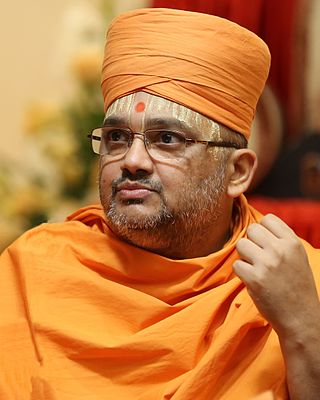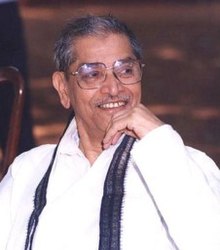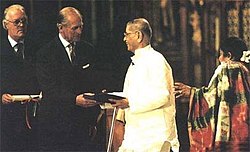Hinduism is an Indian religion or dharma, a religious and universal order or way of life by which followers abide. The word Hindu is an exonym, and while Hinduism has been called the oldest religion in the world, it has also been described as sanātana dharma, a modern usage, based on the belief that its origins lie beyond human history, as revealed in the Hindu texts. Another endonym for Hinduism is Vaidika dharma.
Nirvāṇa is a concept in Indian religions that represents the ultimate state of soteriological release, the liberation from duḥkha, suffering, and saṃsāra, the cycle of birth and rebirth.
The following outline is provided as an overview of and topical guide to Hinduism:

Vinayak Narahari Bhave, also known as Vinoba Bhave, was an Indian advocate of nonviolence and human rights. Often called Acharya, he is best known for the Bhoodan Movement. He is considered as National Teacher of India and the spiritual successor of Mahatma Gandhi. He was an eminent philosopher. The Gita has been translated into the Marathi language by him with the title Geetai.

Swami Prabhavananda was an Indian philosopher, monk of the Ramakrishna Order, and religious teacher. He moved to America in 1923 to take up the role of assistant minister in the San Francisco Vedanta Society. In 1928 he was the minister of a small group in Portland, OR, but in 1930 he founded the Vedanta Society of Southern California. The Swami spent the rest of his life there, writing and collaborating with some of the most distinguished authors and intellectuals of the time, including Aldous Huxley, Christopher Isherwood, and Gerald Heard.

Karma yoga, also called Karma marga, is one of the four classical spiritual paths in Hinduism, one based on the "yoga of action", the others being Jnana yoga, Rāja yoga and Bhakti yoga. To a karma yogi, right action is a form of prayer. The paths are not mutually exclusive in Hinduism, but the relative emphasis between Karma yoga, Jnana yoga and Bhakti yoga varies by the individual.
The following list consists of notable concepts that are derived from Hindu culture and associated cultures’ traditions, which are expressed as words in Sanskrit or other Indic languages and Dravidian languages. The main purpose of this list is to disambiguate multiple spellings, to make note of spellings no longer in use for these concepts, to define the concept in one or two lines, to make it easy for one to find and pin down specific concepts, and to provide a guide to unique concepts of Hinduism all in one place.
The Swadhyaya Movement or Swadhyaya Parivara started in mid 20th-century in the western states of India, particularly Maharashtra and Gujarat. Founded by Pandurang Shastri Athavale (1920-2003), the movement emphasizes self-study (swadhyaya), selfless devotion (bhakti) and application of Indian scriptures such as the Upanishads and Bhagavad gita for spiritual, social and economic liberation.

Dhyāna in Hinduism means contemplation and meditation. Dhyana is taken up in Yoga practices, and is a means to samadhi and self-knowledge.

Notable social reformers in India included

Antarnaad was a 1991 Hindi film made by Shyam Benegal, based on the Swadhyay Movement by Pandurang Shastri Athavale.

The Bhagavad Gita, often referred to as the Gita, is a 700-verse Hindu scripture, which is part of the epic Mahabharata. It forms the chapters 23–40 of book 6 of the Mahabharata called the Bhishma Parva. The work is dated to the second half of the first millennium BCE.
Hindu denominations, sampradayas, traditions, movements, and sects are traditions and sub-traditions within Hinduism centered on one or more gods or goddesses, such as Vishnu, Shiva, Shakti and so on. The term sampradaya is used for branches with a particular founder-guru with a particular philosophy.
Shripad Damodar Satwalekar was a polymath with interests in painting, social health, Ayurveda, Yoga, and Vedic literature. He was also the founder of the Swadhyay Mandal - A Vedic Research Institute.
Jayshree Talwalkar, also known as Didiji, which literally translates as elder sister in Hindi, is an Indian philosopher, spiritual leader, social reformer. She has represented Swadhyay and Indian philosophy at different conferences.
Dhṛti or Dhriti or Dhruti, one of the yamas, means to 'act with determination', 'patience', 'firmness', and refers to 'perseverance', 'wearing regularly', and to one of the eleven Rudrāṇīs There is no correct equivalent English word for dhrti which is derived from dhr- meaning 'to bear'.

Bhadreshdas Swami is a Sanskrit scholar and an ordained monk of the Bochasanwasi Akshar Purushottam Swaminarayan Sanstha (BAPS). In 2007 he completed the Swaminarayan Bhashyam, a five-volume classical Sanskrit commentary on the Prasthanatrayi. This commentary on Hinduism's three canonical texts: the Upanishads, Bhagavad Gita, and the Brahma sutras, forms the interpretive foundation of the philosophy of Akshar Purushottam darshana, also known as Swaminarayan darshana, illuminating the Vedic roots of the Akshar Purushottama philosophy, which was propagated by the 19th-century Hindu leader, Swaminarayan and later by Shastriji Maharaj.

Mohammed Hanif Khan Shastri was an Indian Sanskrit scholar. He is winner of National Communal Harmony Award, in the individual category for the year 2009. The Government of India awarded him fourth highest civilian award Padma Shri in 2019. He has been professor at Rashtriya Sanskrit Sansthan.
Sanātanī is a term used to describe Hindu duties that incorporate teachings from the Vedas, Upanishads, Puranas, and other Hindu religious texts and scriptures such as the Ramayana and its many versions, as well as the Mahabharata, which itself is often described as a concise guide to Hindu philosophy and a practical, self-contained guide to life. The word Sanātanī is coined from Sanātana Dharma which refers to the idea that its origins lie beyond human history, as revealed in the Hindu texts.










